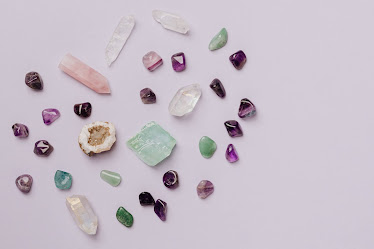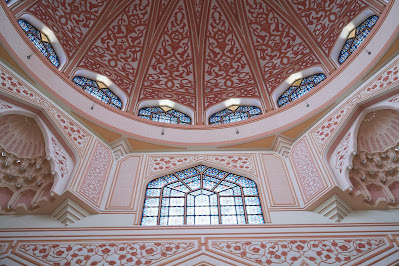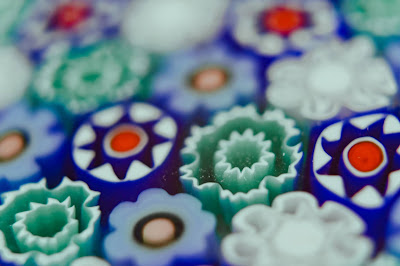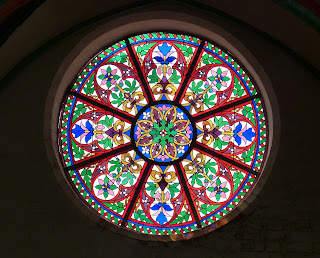Followings are the objects of early Islamic Art.
- Rock-cut crystals.
- Cut and engraved Glass.
- Millefiori
- Stained Glass.
- Etched Glass.
- Cast Glass.
- Tools of Glassmaking.
- The Blowpipe.
Rock-cut Crystals :
Rock crystals ewers are pitchers craved from a single block of rock crystal. They were made by Islamic Fatimid artisans and are considered to be amongst the rarest object in Islamic art. Great skill was required to hollow out the raw rock crystal without breaking it and to carve the delicate, often very shallow, decoration.
 |
Rock cut crystals |
Cut and Engraved Glass :
Cold-cut glass became the most prominent art form of decoration in the early Islamic period, especially in the 9th and 10th centuries. While this lapidary technique is as old as glass making itself, dating well before glassblowing was invented; Roman and Sasanian cut glass provided immediate models. From Egypt to Iran, Islamic cut and engraved decoration took various forms. ranging from complex relief patterns created using mechanically operated wheels and drills to hair width incisions made with a pointed tool.
 |
Cut and Engraved glass |
Millefiori :
Taken from the Italian words ''mille'' and ''fiori'' beads using this ancient Venetian technique are aptly named ''a thousand flowers ''. Prior to the term millefiori being used to describe it. This glasswork technique was simply called mosaic. The ancient Romans, Phoenicians, and Alexandrians are thought to have been the originators of this art-form making Itlay the premier glass working center of the world. In the late 13th century Venetian glassmakers were ordered by the Venetian republic to move their foundries to the island of Murano.
 |
Millefiori |
The millefiori technique was rediscovered in the 8th or 9th century in Mesopotamia and was probably used in the production of objects for the ' Abbasid caliphs in Baghdad or Samarra. A number of surviving bowls and tiles suggest that it was used both for domestic furnishings and interior decoration. Examples such as these show the sophistication and range of Abbasid glassmakers.
Stained Glass :
The glass that has been colored, enameled, painted, or stained, especially by having pigments baked onto its surface or by having various metallic oxides fused into it a used in church windows, decorative lampshades. Stained glass is an art form in which colored glass is cut into shapes and placed into mosaics to form a picture. The glass is held in place by metal strips soldered together to give the stained glass strength and stability. Often, fine details of the scene are painted on the colored glass, which is then heated to bond the paint to the glass, and thereby 'stained'.
 |
Stained Glass |
Etched Glass :
It is the result of international and often artistic carrying of the surface of the glass to leave a white, frosted finish. This technique is used to create designs on the glass. Etched glass can be found in a wide variety of decorative contexts, including glass doors and windows, furniture, wine bottles, and serving dishes such as glass platters. There are three ways to create a piece of etched glass: sandblasting, chemical etching, and acid etching.
Cast Glass:
Glass casting is the process in which glass objects are cast by directing molten glass into a mold where it solidifies.
The process of casting glass in molds was invented in the mid 2nd millennium BC. Although the core-formed method predominated in glass manufacture in the Greek world, casting techniques also played an important role in the development of glass in the 9th to 4th centuries B.C. Cast glass was produced in two basic ways, through the lost-wax method, and with various open molds.
Tools of Glass Makers :
Since the invention of glassblowing in the 1st century B.C., glassmakers have been using the same tools to model, manipulate, and decorate the molten glass. Two mold forms from the medieval Islamic world are the only ones to survive, but the basic technology of nonindustrial glassmaking and the tools employed have not changed.
The blowpipe :
It is an iron or steel tube, usually about five feet long, for blowing the molten glass. Molds are used to impress decorative patterns on the molten glass. Dip molds have the typical form of the conical beaker, but two or three-part hinged molds were also used in the Islamic world.
Stay tuned. Thank you




I've always had wanted to learn how to do this. Very interesting article
ReplyDeleteVery interesting
ReplyDeleteIt's enlightening 👍🏻
ReplyDelete